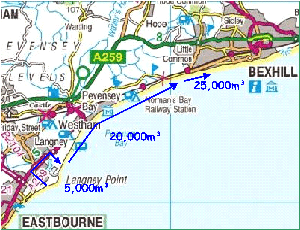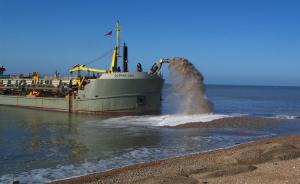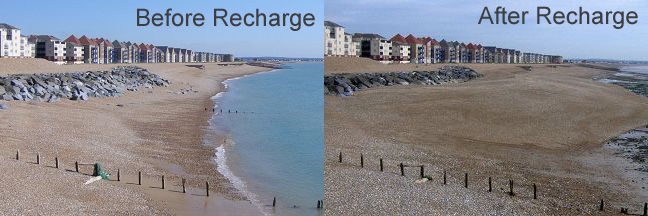Recharge
 Waves that predominate from the southwest mean that shingle beach material is transported along the Channel coast from west to east. This natural transport has been interrupted and there is no longer a natural feed of material around Sovereign Harbour. Longshore drift still occurs along Pevensey Bay, roughly at 25,000cu.m per year, which passes annually onto the Bexhill frontage. Some 5,000cu.m arrives on the western side of Sovereign Harbour, and this is transferred by lorry around the harbour and added to the beach on the eastern side. Even with this transfer process there is a natural shortage of some 20,000cu.m of beach material. This is most visible at the start of the 'conveyor belt', immediately east of Sovereign Harbour. Therefore in order to maintain the overall beach volume additional aggregate has to be brought in from offshore every summer.
Waves that predominate from the southwest mean that shingle beach material is transported along the Channel coast from west to east. This natural transport has been interrupted and there is no longer a natural feed of material around Sovereign Harbour. Longshore drift still occurs along Pevensey Bay, roughly at 25,000cu.m per year, which passes annually onto the Bexhill frontage. Some 5,000cu.m arrives on the western side of Sovereign Harbour, and this is transferred by lorry around the harbour and added to the beach on the eastern side. Even with this transfer process there is a natural shortage of some 20,000cu.m of beach material. This is most visible at the start of the 'conveyor belt', immediately east of Sovereign Harbour. Therefore in order to maintain the overall beach volume additional aggregate has to be brought in from offshore every summer.
Pevensey beach is largely formed of gravel and sand pushed landward from the Channel floor by rising sea levels following the last ice age. Material used to replenish the beach today is also taken from the sea bed and is thus a very close match for the existing beach.
 Layers of sand and gravel are sucked from the seabed by the dredger 'Sospan Dau' and delivered to the beach over high tide. The dredger comes very close to the beach and discharges a mixture of sediment and water using a technique known as 'rainbowing' that creates a mound of material high on the foreshore. Discharge takes about one hour and the vessel returns to the dredge area for the next load with the intention of being back on the beach for the next high tide. Once replenishment has started, the operation is continuous until the required volumes have been delivered. Only adverse weather conditions in either discharge or dredging areas will temporarily delay the operation. This is why replenishment is carried out during the summer months so as to coincide with what should be the most favourable sailing conditions.
Layers of sand and gravel are sucked from the seabed by the dredger 'Sospan Dau' and delivered to the beach over high tide. The dredger comes very close to the beach and discharges a mixture of sediment and water using a technique known as 'rainbowing' that creates a mound of material high on the foreshore. Discharge takes about one hour and the vessel returns to the dredge area for the next load with the intention of being back on the beach for the next high tide. Once replenishment has started, the operation is continuous until the required volumes have been delivered. Only adverse weather conditions in either discharge or dredging areas will temporarily delay the operation. This is why replenishment is carried out during the summer months so as to coincide with what should be the most favourable sailing conditions.

It is traditional for delivered material to be recovered or pushed into place by a bulldozer once the tide has receded. August 2009 saw an experiment whereby the entire 20,000cu.m of delivered shingle was left in situ as delivered by Sospan Dau. This allowed it to be redistributed by the sea, providing a more natural sorting of its different sized constituents. This proved to be very successful in that;
- the beach performed perfectly well without being mechanically moved,
- having no bulldozer meant far less inconvenience for harbour residents, and
- savings were achieved because less resources were used.

Nature in the form of longshore transport moves all sediment from west to east, so beach replenishment is now aimed entirely to the east side of Sovereign Harbour. Its natural migration then means that the whole Bay benefits from the material as it moves towards Cooden.




